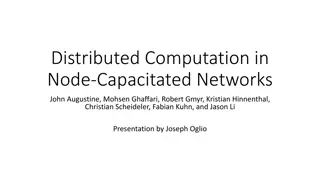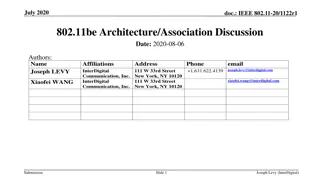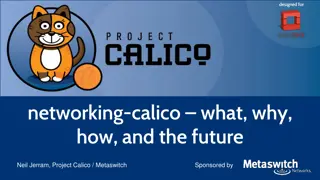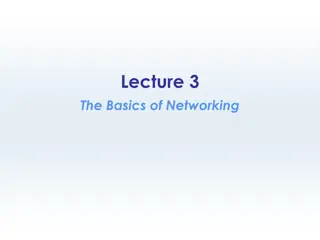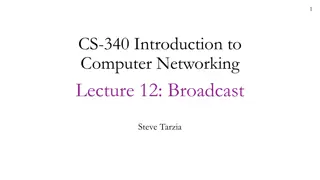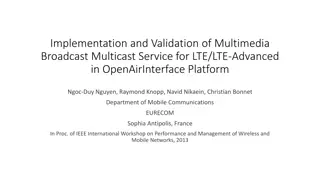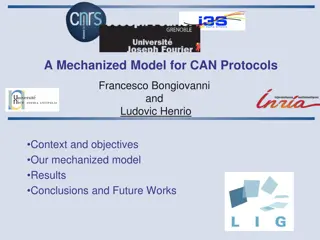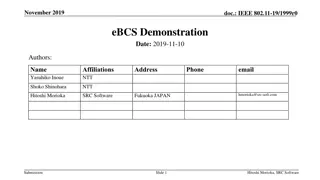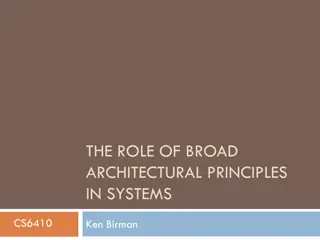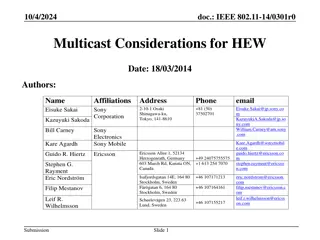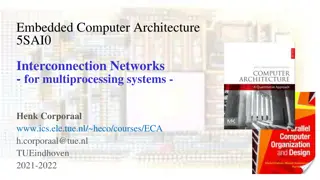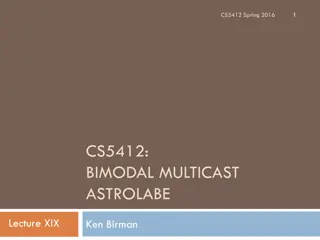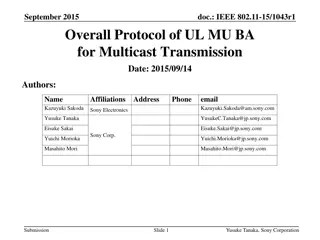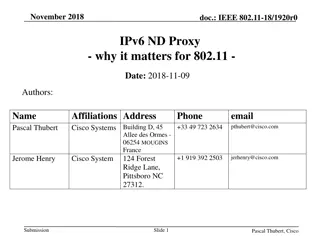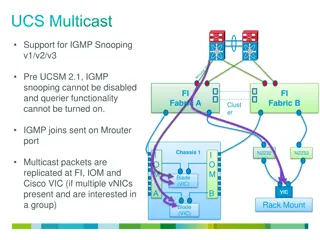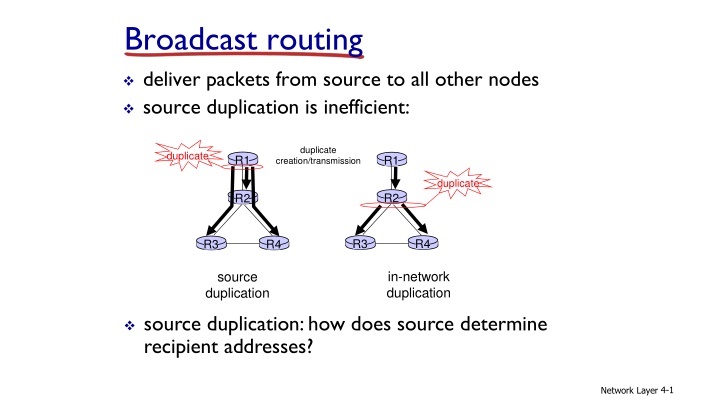
Efficient Multicast Routing Techniques for Network Optimization
Discover the intricacies of broadcast and in-network duplication in network routing to improve packet delivery efficiency. Explore controlled flooding, spanning tree construction, and multicast routing approaches for optimizing network performance and reducing redundancy.
Download Presentation

Please find below an Image/Link to download the presentation.
The content on the website is provided AS IS for your information and personal use only. It may not be sold, licensed, or shared on other websites without obtaining consent from the author. If you encounter any issues during the download, it is possible that the publisher has removed the file from their server.
You are allowed to download the files provided on this website for personal or commercial use, subject to the condition that they are used lawfully. All files are the property of their respective owners.
The content on the website is provided AS IS for your information and personal use only. It may not be sold, licensed, or shared on other websites without obtaining consent from the author.
E N D
Presentation Transcript
Broadcast routing deliver packets from source to all other nodes source duplication is inefficient: duplicate duplicate R1 R1 creation/transmission duplicate R2 R2 R3 R4 R3 R4 in-network duplication source duplication source duplication: how does source determine recipient addresses? Network Layer 4-1
In-network duplication flooding: when node receives broadcast packet, sends copy to all neighbors problems: cycles & broadcast storm controlled flooding: node only broadcasts pkt if it hasn t broadcast same packet before node keeps track of packet ids already broadacsted or reverse path forwarding (RPF): only forward packet if it arrived on shortest path between node and source spanning tree: no redundant packets received by any node Network Layer 4-2
Spanning tree first construct a spanning tree nodes then forward/make copies only along spanning tree A A B B c c D D E F E F G G (b) broadcast initiated at D (a) broadcast initiated at A Network Layer 4-3
Spanning tree: creation center node each node sends unicast join message to center node message forwarded until it arrives at a node already belonging to spanning tree A A 3 B B c c 4 2 D D E E F F 5 1 G G (a) stepwise construction of spanning tree (center: E) (b) constructed spanning tree Network Layer 4-4
Multicast routing: problem statement goal: find a tree (or trees) connecting routers having local mcast group members tree:not all paths between routers used shared-tree:same tree used by all group members source-based:different tree from each sender to rcvrs legend group member not group member router with a group member router without group member shared tree source-based trees Network Layer 4-5
Approaches for building mcast trees approaches: source-based tree: one tree per source shortest path trees reverse path forwarding group-shared tree: group uses one tree minimal spanning (Steiner) center-based trees we first look at basic approaches, then specific protocols adopting these approaches Network Layer 4-6
Shortest path tree mcast forwarding tree: tree of shortest path routes from source to all receivers Dijkstra s algorithm LEGEND s: source R1 2 router with attached group member R4 1 R2 5 router with no attached group member 3 4 R5 link used for forwarding, i indicates order link added by algorithm i 6 R3 R7 R6 Network Layer 4-7
Reverse path forwarding rely on router s knowledge of unicast shortest path from it to sender each router has simple forwarding behavior: if (mcast datagram received on incoming link on shortest path back to center) then flood datagram onto all outgoing links else ignore datagram Network Layer 4-8
Reverse path forwarding: example s: source LEGEND R1 R4 router with attached group member R2 router with no attached group member R5 datagram will be forwarded R3 R7 R6 datagram will not be forwarded result is a source-specific reverse SPT may be a bad choice with asymmetric links Network Layer 4-9
Reverse path forwarding: pruning forwarding tree contains subtrees with no mcast group members no need to forward datagrams down subtree prune msgs sent upstream by router with no downstream group members s: source LEGEND R1 R4 router with attached group member R2 P router with no attached group member R5 P prune message links with multicast forwarding R3 P R6 R7 Network Layer 4-10
Shared-tree: steiner tree steiner tree: minimum cost tree connecting all routers with attached group members problem is NP-complete excellent heuristics exists not used in practice: computational complexity information about entire network needed monolithic: rerun whenever a router needs to join/leave Network Layer 4-11
Center-based trees single delivery tree shared by all one router identified as center of tree to join: edge router sends unicast join-msg addressed to center router join-msg processed by intermediate routers and forwarded towards center join-msg either hits existing tree branch for this center, or arrives at center path taken by join-msg becomes new branch of tree for this router Network Layer 4-12
Center-based trees: example suppose R6 chosen as center: LEGEND R1 router with attached group member R4 3 router with no attached group member R2 2 1 R5 path order in which join messages generated R3 1 R6 R7 Network Layer 4-13
Internet Multicasting Routing: DVMRP DVMRP: distance vector multicast routing protocol, RFC1075 flood and prune: reverse path forwarding, source-based tree RPF tree based on DVMRP s own routing tables constructed by communicating DVMRP routers no assumptions about underlying unicast initial datagram to mcast group flooded everywhere via RPF routers not wanting group: send upstream prune msgs Network Layer 4-14
DVMRP: continued soft state: DVMRP router periodically (1 min.) forgets branches are pruned: mcast data again flows down unpruned branch downstream router: reprune or else continue to receive data routers can quickly regraft to tree following IGMP join at leaf odds and ends commonly implemented in commercial router Network Layer 4-15
Tunneling Q: how to connect islands of multicast routers in a sea of unicast routers? logical topology physical topology mcast datagram encapsulated inside normal (non- multicast-addressed) datagram normal IP datagram sent thru tunnel via regular IP unicast to receiving mcast router (recall IPv6 inside IPv4 tunneling) receiving mcast router unencapsulates to get mcast datagram Network Layer 4-16
PIM: Protocol Independent Multicast not dependent on any specific underlying unicast routing algorithm (works with all) two different multicast distribution scenarios : sparse: # networks with group members small wrt # interconnected networks group members widely dispersed bandwidth not plentiful dense: group members densely packed, in close proximity. bandwidth more plentiful Network Layer 4-17
Consequences of sparse-dense dichotomy: dense group membership by routers assumed until routers explicitly prune data-driven construction on mcast tree (e.g., RPF) bandwidth and non-group- router processing profligate sparse: no membership until routers explicitly join receiver- driven construction of mcast tree (e.g., center- based) bandwidth and non-group- router processing conservative Network Layer 4-18
PIM- dense mode flood-and-prune RPF:similar to DVMRP but underlying unicast protocol provides RPF info for incoming datagram less complicated (less efficient) downstream flood than DVMRP reduces reliance on underlying routing algorithm has protocol mechanism for router to detect it is a leaf-node router Network Layer 4-19
PIM - sparse mode center-based approach router sends join msg to rendezvous point (RP) intermediate routers update state and forward join after joining via RP, router can switch to source- specific tree increased performance: less concentration, shorter paths R1 R4 join R2 join R5 join R3 R6 R7 all data multicast from rendezvous point rendezvous point Network Layer 4-20
PIM - sparse mode sender(s): unicast data to RP, which distributes down RP-rooted tree RP can extend mcast tree upstream to source RP can send stop msg if no attached receivers no one is listening! R1 R4 join R2 join R5 join R3 R6 R7 all data multicast from rendezvous point rendezvous point Network Layer 4-21


